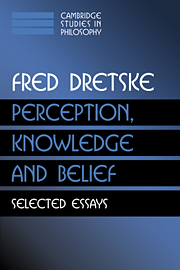Book contents
2 - Epistemic Operators
Published online by Cambridge University Press: 19 December 2009
Summary
Suppose Q is a necessary consequence of P. Given only this much, it is, of course, quite trivial that if it is true that P, then it must also be true that Q. If it is a fact that P, then it must also be a fact that Q. If it is necessary that P, then it is necessary that Q; and if it is possible that P, then it must also be possible that Q.
I have just mentioned four prefixes: “it is true that,” “it is a fact that,” “it is necessary that,” and “it is possible that.” In this essay I shall refer to such affixes as sentential operators or simply operators; when affixed to a sentence or statement, they operate on it to generate another sentence or statement. The distinctive thing about the four operators I have just mentioned is that, if Q is a necessary consequence of P, then the statement we get by operating on Q with one of these four operators is a necessary consequence of the statement we get by operating on P with the same operator. This may be put more succinctly if we let “O” stand for the operator in question and “O(P)” for the statement we get by affixing the operator “O” to the statement “P.” We can now say that the preceding four operators share the following property: if P entails Q, then O(P) entails O(Q).
- Type
- Chapter
- Information
- Perception, Knowledge and BeliefSelected Essays, pp. 30 - 47Publisher: Cambridge University PressPrint publication year: 2000
- 19
- Cited by

